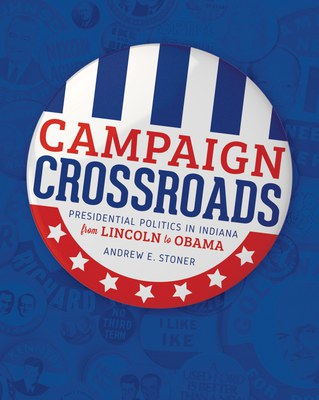
Plan your visit
Hot Off The Press: Campaign Crossroads
April 24, 2017

During the late 19th and early 20th centuries, Indiana played a vital role in national politics, with Hoosiers often represented on national party tickets. Legend has it that the first words from an Indiana child were, taking off on William Tecumseh Sherman?s declaration, If nominated I will run and if elected I will serve.?
IHS Press’s new book, Campaign Crossroads: Presidential Politics in Indiana from Lincoln to Obama, looks back over the varied, sometimes important, sometimes irrelevant, but always interesting presidential cycles in the state?s history.
Campaign Crossroads author Andrew E. Stoner, an Indiana native, worked in Governor Frank O’Bannon’s administration and wrote about his legacy. An assistant professor of public relations in the Department of Communication Studies at California State University, Sacramento, Stoner holds a doctorate in public communication and technology from Colorado State University, a master’s degree in journalism from Ball State University, and bachelor’s degree in journalism from Franklin College. Here he talks about his work on Campaign Crossroads.
What inspired you to write about Indiana presidential visits?
I have long enjoyed the intersection of journalism and politics, so much so I decided at a very young age I wanted to work in the communication field. At age 13, I was totally committed to attending a speech by then-former President Gerald R. Ford at Goshen High School in December 1977. I cannot remember so much what President Ford had to say that night, but I was in awe of the man and the respect my fellow citizens offered him. Over time I came to more fully understand Ford’s place in history, and it is one of honor. Working in state government, and for Governor Frank O’Bannon, I also had opportunities to be exposed to presidential politics in Indiana and I thought it was an interesting topic.
What was your most valuable source when writing the book?
Since I decided to focus on how local communities and their media covered these events, I relied a lot upon newspaper archives, microfilms, and, of course, books and other resources published about the topic. I am a firm believer that journalists often write the first draft of history with the understanding that they sometimes they get it right, and sometimes wrong. But there’s no question local journalists, even the most partisan ones, share amazing descriptions and accounts of singularly important days in the lives of Indiana communities, big and small.
Are Hoosier voters different from the rest of America?
I think Indiana voters are certainly more conservative, in most respects, but I also think they seek genuineness and authenticity in the process. I think there is ample evidence that candidates who have done well in Indiana have also spent a great deal of time among Hoosiers, listening to them and, of course, asking for their vote. Even sitting presidents (especially Republicans) have understood this. I would not, however, agree that Hoosiers are some special kind of bellwether for national campaigns. Indiana voters have often backed the second-place finisher in the quadrennial exercise of electing a president.
Is there one incident from the time period you covered that particularly attracted your interest?
There were many, but all of the years where the railroad was so important and central to campaigning fascinates me. This is an experience most of us have never had as Governor O’Bannon used to say, about putting on our glad clothes, and heading to town. The closest I ever came to that was the Ford visit I mentioned from 1977. There’s something special about being in that collective, that mass of citizens who are seeing and hearing from our leaders. That does not mean all of those aggregate groups of citizens are united in their political views, but they are of one mind about the value and importance of a participatory democracy.

If you could pick one presidential campaign to work on as a staff member, which one would it be?
I am sure men such as Theodore Roosevelt, Harry Truman and Richard Nixon would wear me out they seemed to have endless energy for campaigning. Noting that, I think I’d probably go for someone who reflected my own political values, and could turn a phrase with the power to move people. My research allowed me to discover Indiana’s own Benjamin Harrison – what a fine, personal, kind speaker. He never set the world on fire, I’m sure, but the words offered from his front porch are of matchless sincerity. On an earnestness scale, Harrison is clearly Abraham Lincoln’s equal. In terms of making history, having an impact, the campaigns of Robert F. Kennedy, Hillary Clinton and Barack Obama are probably ones I would sign up for with little hesitation.
Are you working on another book?
Yes, I have two projects underway. My dissertation about the life and work of journalist and author Randy Shilts (1951-1994) is before editors at a university press for publication hopefully in 2018. I also am working on a sort of follow-up to some of my previous work in true crime. Courthouse Chaos looks at county courthouses as the setting for some incredible, often heart-breaking and amazing moments in communities big and small across America. The courthouse has long been an organizing element for the community it?s where every type of civil and criminal dispute is settled. That settlement sometimes comes amidst emotion, and even violence, that spirals out of control, and I find those stories interesting and revealing.









